Survivors’ Stories: Masaru Kurisu, 85, Naka Ward, Hiroshima City
May 27, 2024
Unconscious for month after atomic bombing
Losing two brothers, suffering from laryngeal cancer, he decided to speak
by Kyoko Niiyama, Staff Writer
Masaru Kurisu, 85, suffered burns in the atomic bombing and was unconscious for about one month. His two older brothers were killed in the bombing. He was diagnosed with laryngeal cancer about 15 years ago, “nearly dying twice in the atomic bombing.” Based on that experience, he has now resolved to “do what little I can to eliminate war from the world with this life I have been granted.”
In 1945, Mr. Kurisu, six years old at the time, was living with his parents and two brothers in the area of Yoshijima-honmachi (now part of the city’s Naka Ward) in Hiroshima. However, with their home slated for demolition to create fire lanes in the city, the family of five had moved nearby.
On the morning of August 6, his father had gone to work outside the city. His older brothers, Nobuhiko, 15 at the time and a fourth-year student at Sanyo Junior High School (present-day Hiroshima Sanyo High School, in the city’s Nishi Ward), and Teruaki, 13, a first-year student at the same school, had also left the house to work as mobilized students. His mother and oldest sister, who was pregnant and had returned home, were in the main part of the house.
Mr. Kurisu was playing alone in a separate area when suddenly there was a flash. He remembers that his hair “felt like it was being slowly burned,” but he then lost consciousness. It was around two kilometers from the hypocenter.
Trapped between a collapsed wall and a chest of drawers, Mr. Kurisu heard later that he had been rescued by his mother and others. His uncle, who lived in Yanai City in Yamaguchi Prefecture, rushed to Hiroshima and brought Mr. Kurisu, whose face was burned and swollen, back to his home. Thanks to his uncle’s devoted care, Mr. Kurisu lived.
He regained consciousness about one month later and was able to return to Hiroshima by the end of the year. However, his two brothers were not in the shack built on the site where their home had once stood.
On the day of the bombing, it is believed that Nobuhiko had been mobilized for work in the city center, but his whereabouts remain unknown. Teruaki experienced the atomic bombing in the Zakoba-cho area (now part of Hiroshima’s Naka Ward), near the hypocenter, while engaged in building-demolition work. He was reportedly taken to Koyaura National School (present-day Koyaura Elementary School) in the town of Saka-cho. About one week after the bombing, his mother received a postcard from Teruaki with the message, “Please pick me up as soon as possible.” She hurried to the school but was too late. Her son had died two days before she arrived.
In the chaos after the bombing, Teruaki was cremated along with other bodies, with the family not even able to receive his ashes. Mr. Kurisu learned about his brothers from his relatives because his parents could never speak of the situation while they were alive. Mr. Kurisu said, “My mother and brother must have believed they would see each other alive again. There is nothing more tragic than that.”
Mr. Kurisu attended an elementary, junior and senior high school affiliated with Hiroshima University. After graduating from high school, he entered a university in Tokyo and then went to New York in the United States, where he studied business administration in graduate school. Making the most of his English skills, he opened an English school at his home in 1968 and poured himself into managing the school over the course of 20 years. He distanced himself from his memories of the atomic bombing.
At the age of 70, however, he developed laryngeal cancer and was recognized as suffering from an A-bomb disease. Because he lost his vocal cords, he now uses a special device that helps with vocalization by pressing it against the skin under his jaw. He became painfully aware of the fear of radiation that threatens people throughout their lives and was reminded of his experience 79 years ago.
Last summer, through Hiroshima Sanyo High School, he was interviewed by a British television station, speaking in public for the first time about his A-bombing experience. He recalled that, “I felt then that the world was awaiting messages of peace from Japan.” He added, “Nuclear weapons still exist today and many people are suffering from war.” That experience served as the impetus for his decision to share his experience as an A-bomb survivor.
“Do not leave things in the hands of a group of people like politicians. Each of us must act as if this is a matter of life or death.” While his “voice” reproduced by the device has a monotone quality, he communicates his sincere feelings by gesturing with his body and hands.
(Originally published on May 27, 2024)










